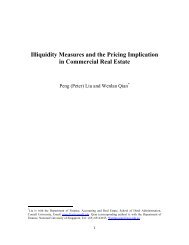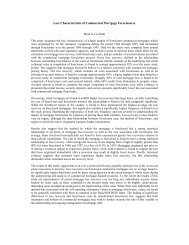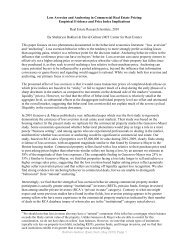Commercial Mortgage Delinquency, Foreclosure and Reinstatement
Commercial Mortgage Delinquency, Foreclosure and Reinstatement
Commercial Mortgage Delinquency, Foreclosure and Reinstatement
You also want an ePaper? Increase the reach of your titles
YUMPU automatically turns print PDFs into web optimized ePapers that Google loves.
The six geographic regions are Quebec, Ontario, Alberta, British Columbia, Atlantic(which includes the provinces of Newfoundl<strong>and</strong>, Nova Scotia, Prince Edward Isl<strong>and</strong> <strong>and</strong> NewBrunswick) <strong>and</strong> Prairie (which includes the provinces of Saskatchewan <strong>and</strong> Manitoba). Theregion with the highest proportion of loans is Ontario, followed by Quebec.The size of the mortgage is measured as the outst<strong>and</strong>ing balance at the time of the firstobservation; the average was $4.1 million (Canadian). The average contract interest rate,measured as a percentage, was 9.7. The spread was calculated as the difference between thecontract rate <strong>and</strong> the prime market rate, divided by the prime market rate. The lender-suppliedmarket rate is based on a prime mortgage with a matching term. Therefore, high spreads wouldbe observed under several circumstances. If rates have fallen since loan initiation, then highspreads would be observed. But in addition, loans that were initiated at a high contract rate due toelevated risk will also have higher spreads. Further, loans that were initiated with long terms thatare now reaching maturity will have higher spreads even if rates have not fallen, if the usual yieldcurve slope is assumed.Other variables were considered but not used. The seasoning of the loan was notavailable since the lender’s records sometimes report date since initiation <strong>and</strong> sometimes datesince the last renewal. Since the proportion of insured mortgages was less than 2.5% (only smallapartment buildings), it was not usable. Similarly, mortgage priority is not used since only 2.2%of loans were second mortgages. Property vacancy rates were not used due to data unavailability.The property income return <strong>and</strong> income return volatility over the previous 5 years was calculatedfor each loan’s property type <strong>and</strong> region. These variables were included in initial specificationsbut were never significant.The descriptive statistics broken down by loan status provide some interesting insightswhen the values for never delinquent loans are compared to delinquent but reinstated loans <strong>and</strong>foreclosed loans. The average loan-to-value ratio monotonically increases across the threecategories, with the lowest value for never delinquent loans, the next lowest value for reinstated9





